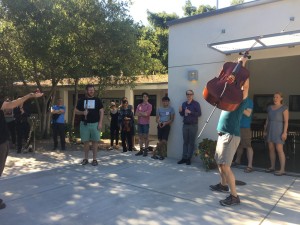Blog
Eighth Blackbird Creative Lab
Originally published in Newcity Magazine 1/6/2018
It’s a funny thing about classical music that the folks who write the music are very often not the ones who play it. We composers rely heavily on learning to notate our musical ideas accurately so that music ensembles can bring them to life even if we can’t be in the room to answer questions, are not available to Skype or, in the case of many composers, have been dead for centuries.
But as amazing as the concept of notating sound is—and it is amazing—notated music still has its downsides. Notes on a page have an inherently sterile quality. Nothing feels stranger as a composer than playing a hot lick on the piano and then translating that musical energy into dispassionate black dots on a white page. You try to convey your idea by writing score directions above the notes like “with energy,” “bouncy” or “this is a hot lick, dammit!” but it’s not the same as just playing it would be.
Notation is inherently a nonmusical way to express yourself musically. Writing music down uses a different part of your brain than creating music, and notation functions by its very nature as a barrier between the composer and musician, or even as a barrier between the composer and his or her own ideas.
Notated music also serves as a crutch, enabling the musicians to play the piece hundreds of times without ever memorizing it, which has created the enduring image of a classical music concert in which the musicians spend the whole time staring into their music stands. Lastly, notation has resulted in a focus on perfection. Musicians spend years interpreting the black dots on the page trying to find exactly what the composer wanted so they can play it unerringly night after night in concert, which is nice and all, but as you can imagine, doesn’t make for a stirring performance aesthetic.
Composer Erik Satie had fun with overzealous score interpretation. He delighted in writing things in his scores like “wonder about yourself,” “open your mind” and my personal favorite, “like a nightingale with a toothache.” It took a dozen or so academic treatises on how to play the piano like a nightingale with a toothache before people finally realized he was messing with them.
In the past, most classical music ensembles spent so much time interpreting music notation that they didn’t think about performance aesthetics. They took to the stage dressed in drab colors, said nothing to the audience, sat down, played for a while ,and then at some point stood up, took a bow and went home. They believed that they were only responsible for the notes on the page, that their job was to interpret the black dots as best they could and to dedicate themselves to a perfect performance.
But the times are changing. For many new ensembles, interpreting the score at a very high level is only one aspect of the performance, to be combined with an exciting stage presence. Possibly the ensemble most dedicated to bringing a groundbreaking new performance style to classical music is contemporary music chamber group Eighth Blackbird.
I first heard Eighth Blackbird many years ago while driving home from a gig and listening to WFMT’s Monday night live in-studio program. I heard this incredible performance of a piece by avant-garde composer George Crumb. When the announcer said that the ensemble had played the piece by memory I was flabbergasted. Playing by memory is common in a solo recital, but it’s very rare for chamber groups to do it, and with a complex contemporary music piece—well, it felt nothing less than miraculous.
Memorizing the music allowed Eighth Blackbird to sort of pretend that it was never notated in the first place, that it arose spontaneously from the group at the time of performance. It allowed them to inject more of themselves into the pieces they played and, most importantly, it freed them from the tyranny of the music stand. In concert, Eighth Blackbird is fun, playful, intense and deeply engaging. Freed from their stands, they prowl restlessly around the stage in tightly choreographed movements that accentuate the music.
The group has recorded numerous albums, three of which won Grammys; they had a high-profile, year-long residence at the MCA in 2016; they’ve collaborated with rock stars like Glenn Kotche and Bryce Dessner; and they’ve been more or less continually on tour for the last twenty years, in which time they’ve honed their stage presence to perfection. Last year they started a new initiative, Blackbird Creative Lab, to share what they’ve learned with other classical musicians in the hopes of radically and forever altering what a classical music performance looks like.
“Blackbird Creative Lab is the culmination and dissemination of the lessons we’ve learned after two decades as a touring new music ensemble and as an organization,” says Nicholas Photinos, Eighth Blackbird’s founding cellist. “Through this intensive two-week, tuition-free program for pre-professional instrumentalists and composers, we hope to inspire a new generation of musicians not only through side-by-side performances, but by working with choreographers, lighting engineers, and sound engineers, giving them the personal and organizational tools to succeed.”
Blackbird Creative Lab is truly ambitious. Not only do they work with budding young performers, but they have a place for emerging composers. Creative Lab results in new pieces, interesting new ideas for dynamic audience-centered performances and an ongoing conversation about how to rebrand classical music.
As a composer, this is exciting stuff for me. Of course we want the ensembles who play our music to be diligent in their interpretation of our music, but a group that can transcend the limits of notation to make the music their own and convey it to an audience in a consistently exciting way is a really powerful thing. And if it becomes a movement that transforms classical music? That would be an incredible thing.
Eighth Blackbird will present a Blackbird Creative Lab Reunion Concert at Constellation, 3111 North Western, January 21-22, featuring alumni from the inaugural workshops this year. More information can be found at the Lab’s website.
- Written by: Seth Boustead
- On: January 6, 2018
News
-
Two New Scores on this Year’s ‘Sound of Silent Film Festival’
I have two new scores on this year’s Sound of Silent Film Festival! The pieces are scored for flute, clarinet, Read More
-
Seth and Gene’s Excellent Electro-Acoustic Adventure Begins at Westbeth March 8
I’m going on tour with my friend Gene Pritsker and it all starts this Saturday night at the famous Westbeth Read More
-
‘Devil’s Food Cake’ Performance in Holland Michigan
We’re taking the Sound of Silent Film Festival on the road to Holland, Michigan where we’re presenting it with Hope Read More
-
New Piece for Viola and Percussion Premiered on January 24
My new work Hurry Up and Wait will be premiered at a Composers Concordance concert of music for viola and Read More
Blog Archives
- July 2022
- June 2022
- April 2022
- March 2022
- January 2022
- October 2021
- September 2021
- August 2021
- February 2021
- November 2020
- October 2020
- June 2020
- April 2020
- January 2020
- December 2019
- November 2019
- October 2019
- September 2019
- July 2019
- June 2019
- May 2019
- April 2019
- March 2019
- January 2019
- December 2018
- November 2018
- October 2018
- September 2018
- August 2018
- July 2018
- May 2018
- April 2018
- March 2018
- February 2018
- January 2018
- December 2017
- November 2017
- October 2017
- September 2017
- August 2017
- July 2017
- June 2017
- May 2017
- April 2017
- March 2017
- February 2017
- January 2017
- December 2016
- November 2016
- October 2016
- September 2016
- July 2016
- June 2016
- May 2016
- April 2016
- March 2016
- February 2016
- January 2016
- December 2015
- November 2015
- October 2015
- September 2015
- August 2015
- July 2015
- June 2015
- May 2015
- April 2015
- March 2015
- February 2015
- January 2015
- December 2014
- November 2014
- October 2014
- September 2014
- August 2014
- July 2014
- June 2014
- May 2014
- April 2014
- March 2014
- February 2014
- January 2014
- December 2013
- November 2013
- October 2013
- September 2013
- August 2013
- March 2011
- August 2010
- May 2010
- October 2009




Leave a Reply